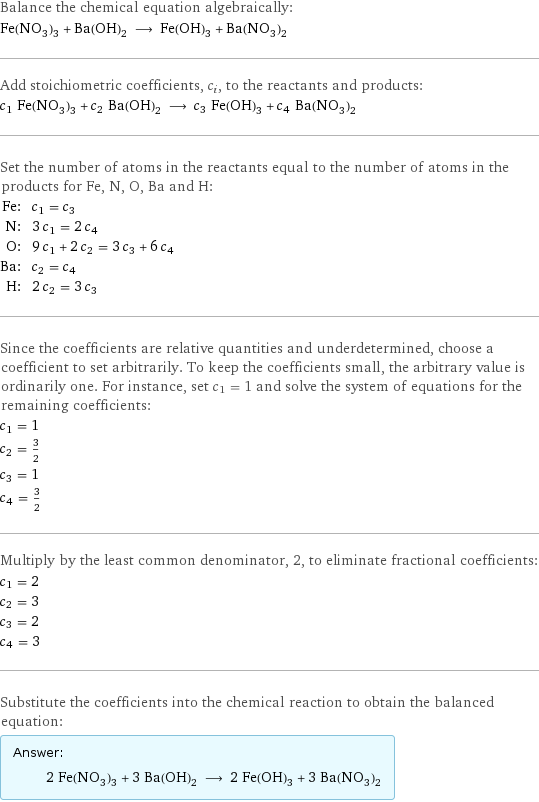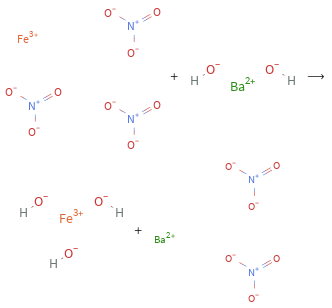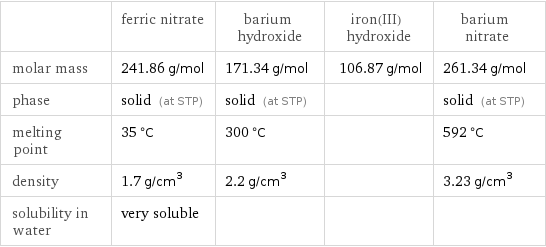Input interpretation

Fe(NO_3)_3 ferric nitrate + Ba(OH)_2 barium hydroxide ⟶ Fe(OH)_3 iron(III) hydroxide + Ba(NO_3)_2 barium nitrate
Balanced equation

Balance the chemical equation algebraically: Fe(NO_3)_3 + Ba(OH)_2 ⟶ Fe(OH)_3 + Ba(NO_3)_2 Add stoichiometric coefficients, c_i, to the reactants and products: c_1 Fe(NO_3)_3 + c_2 Ba(OH)_2 ⟶ c_3 Fe(OH)_3 + c_4 Ba(NO_3)_2 Set the number of atoms in the reactants equal to the number of atoms in the products for Fe, N, O, Ba and H: Fe: | c_1 = c_3 N: | 3 c_1 = 2 c_4 O: | 9 c_1 + 2 c_2 = 3 c_3 + 6 c_4 Ba: | c_2 = c_4 H: | 2 c_2 = 3 c_3 Since the coefficients are relative quantities and underdetermined, choose a coefficient to set arbitrarily. To keep the coefficients small, the arbitrary value is ordinarily one. For instance, set c_1 = 1 and solve the system of equations for the remaining coefficients: c_1 = 1 c_2 = 3/2 c_3 = 1 c_4 = 3/2 Multiply by the least common denominator, 2, to eliminate fractional coefficients: c_1 = 2 c_2 = 3 c_3 = 2 c_4 = 3 Substitute the coefficients into the chemical reaction to obtain the balanced equation: Answer: | | 2 Fe(NO_3)_3 + 3 Ba(OH)_2 ⟶ 2 Fe(OH)_3 + 3 Ba(NO_3)_2
Structures

+ ⟶ +
Names

ferric nitrate + barium hydroxide ⟶ iron(III) hydroxide + barium nitrate
Equilibrium constant
![Construct the equilibrium constant, K, expression for: Fe(NO_3)_3 + Ba(OH)_2 ⟶ Fe(OH)_3 + Ba(NO_3)_2 Plan: • Balance the chemical equation. • Determine the stoichiometric numbers. • Assemble the activity expression for each chemical species. • Use the activity expressions to build the equilibrium constant expression. Write the balanced chemical equation: 2 Fe(NO_3)_3 + 3 Ba(OH)_2 ⟶ 2 Fe(OH)_3 + 3 Ba(NO_3)_2 Assign stoichiometric numbers, ν_i, using the stoichiometric coefficients, c_i, from the balanced chemical equation in the following manner: ν_i = -c_i for reactants and ν_i = c_i for products: chemical species | c_i | ν_i Fe(NO_3)_3 | 2 | -2 Ba(OH)_2 | 3 | -3 Fe(OH)_3 | 2 | 2 Ba(NO_3)_2 | 3 | 3 Assemble the activity expressions accounting for the state of matter and ν_i: chemical species | c_i | ν_i | activity expression Fe(NO_3)_3 | 2 | -2 | ([Fe(NO3)3])^(-2) Ba(OH)_2 | 3 | -3 | ([Ba(OH)2])^(-3) Fe(OH)_3 | 2 | 2 | ([Fe(OH)3])^2 Ba(NO_3)_2 | 3 | 3 | ([Ba(NO3)2])^3 The equilibrium constant symbol in the concentration basis is: K_c Mulitply the activity expressions to arrive at the K_c expression: Answer: | | K_c = ([Fe(NO3)3])^(-2) ([Ba(OH)2])^(-3) ([Fe(OH)3])^2 ([Ba(NO3)2])^3 = (([Fe(OH)3])^2 ([Ba(NO3)2])^3)/(([Fe(NO3)3])^2 ([Ba(OH)2])^3)](../image_source/a2dca9658346d94014de24974034cd34.png)
Construct the equilibrium constant, K, expression for: Fe(NO_3)_3 + Ba(OH)_2 ⟶ Fe(OH)_3 + Ba(NO_3)_2 Plan: • Balance the chemical equation. • Determine the stoichiometric numbers. • Assemble the activity expression for each chemical species. • Use the activity expressions to build the equilibrium constant expression. Write the balanced chemical equation: 2 Fe(NO_3)_3 + 3 Ba(OH)_2 ⟶ 2 Fe(OH)_3 + 3 Ba(NO_3)_2 Assign stoichiometric numbers, ν_i, using the stoichiometric coefficients, c_i, from the balanced chemical equation in the following manner: ν_i = -c_i for reactants and ν_i = c_i for products: chemical species | c_i | ν_i Fe(NO_3)_3 | 2 | -2 Ba(OH)_2 | 3 | -3 Fe(OH)_3 | 2 | 2 Ba(NO_3)_2 | 3 | 3 Assemble the activity expressions accounting for the state of matter and ν_i: chemical species | c_i | ν_i | activity expression Fe(NO_3)_3 | 2 | -2 | ([Fe(NO3)3])^(-2) Ba(OH)_2 | 3 | -3 | ([Ba(OH)2])^(-3) Fe(OH)_3 | 2 | 2 | ([Fe(OH)3])^2 Ba(NO_3)_2 | 3 | 3 | ([Ba(NO3)2])^3 The equilibrium constant symbol in the concentration basis is: K_c Mulitply the activity expressions to arrive at the K_c expression: Answer: | | K_c = ([Fe(NO3)3])^(-2) ([Ba(OH)2])^(-3) ([Fe(OH)3])^2 ([Ba(NO3)2])^3 = (([Fe(OH)3])^2 ([Ba(NO3)2])^3)/(([Fe(NO3)3])^2 ([Ba(OH)2])^3)
Rate of reaction
![Construct the rate of reaction expression for: Fe(NO_3)_3 + Ba(OH)_2 ⟶ Fe(OH)_3 + Ba(NO_3)_2 Plan: • Balance the chemical equation. • Determine the stoichiometric numbers. • Assemble the rate term for each chemical species. • Write the rate of reaction expression. Write the balanced chemical equation: 2 Fe(NO_3)_3 + 3 Ba(OH)_2 ⟶ 2 Fe(OH)_3 + 3 Ba(NO_3)_2 Assign stoichiometric numbers, ν_i, using the stoichiometric coefficients, c_i, from the balanced chemical equation in the following manner: ν_i = -c_i for reactants and ν_i = c_i for products: chemical species | c_i | ν_i Fe(NO_3)_3 | 2 | -2 Ba(OH)_2 | 3 | -3 Fe(OH)_3 | 2 | 2 Ba(NO_3)_2 | 3 | 3 The rate term for each chemical species, B_i, is 1/ν_i(Δ[B_i])/(Δt) where [B_i] is the amount concentration and t is time: chemical species | c_i | ν_i | rate term Fe(NO_3)_3 | 2 | -2 | -1/2 (Δ[Fe(NO3)3])/(Δt) Ba(OH)_2 | 3 | -3 | -1/3 (Δ[Ba(OH)2])/(Δt) Fe(OH)_3 | 2 | 2 | 1/2 (Δ[Fe(OH)3])/(Δt) Ba(NO_3)_2 | 3 | 3 | 1/3 (Δ[Ba(NO3)2])/(Δt) (for infinitesimal rate of change, replace Δ with d) Set the rate terms equal to each other to arrive at the rate expression: Answer: | | rate = -1/2 (Δ[Fe(NO3)3])/(Δt) = -1/3 (Δ[Ba(OH)2])/(Δt) = 1/2 (Δ[Fe(OH)3])/(Δt) = 1/3 (Δ[Ba(NO3)2])/(Δt) (assuming constant volume and no accumulation of intermediates or side products)](../image_source/be406a9d4cb1c6a6f6b68a3632e176bd.png)
Construct the rate of reaction expression for: Fe(NO_3)_3 + Ba(OH)_2 ⟶ Fe(OH)_3 + Ba(NO_3)_2 Plan: • Balance the chemical equation. • Determine the stoichiometric numbers. • Assemble the rate term for each chemical species. • Write the rate of reaction expression. Write the balanced chemical equation: 2 Fe(NO_3)_3 + 3 Ba(OH)_2 ⟶ 2 Fe(OH)_3 + 3 Ba(NO_3)_2 Assign stoichiometric numbers, ν_i, using the stoichiometric coefficients, c_i, from the balanced chemical equation in the following manner: ν_i = -c_i for reactants and ν_i = c_i for products: chemical species | c_i | ν_i Fe(NO_3)_3 | 2 | -2 Ba(OH)_2 | 3 | -3 Fe(OH)_3 | 2 | 2 Ba(NO_3)_2 | 3 | 3 The rate term for each chemical species, B_i, is 1/ν_i(Δ[B_i])/(Δt) where [B_i] is the amount concentration and t is time: chemical species | c_i | ν_i | rate term Fe(NO_3)_3 | 2 | -2 | -1/2 (Δ[Fe(NO3)3])/(Δt) Ba(OH)_2 | 3 | -3 | -1/3 (Δ[Ba(OH)2])/(Δt) Fe(OH)_3 | 2 | 2 | 1/2 (Δ[Fe(OH)3])/(Δt) Ba(NO_3)_2 | 3 | 3 | 1/3 (Δ[Ba(NO3)2])/(Δt) (for infinitesimal rate of change, replace Δ with d) Set the rate terms equal to each other to arrive at the rate expression: Answer: | | rate = -1/2 (Δ[Fe(NO3)3])/(Δt) = -1/3 (Δ[Ba(OH)2])/(Δt) = 1/2 (Δ[Fe(OH)3])/(Δt) = 1/3 (Δ[Ba(NO3)2])/(Δt) (assuming constant volume and no accumulation of intermediates or side products)
Chemical names and formulas

| ferric nitrate | barium hydroxide | iron(III) hydroxide | barium nitrate formula | Fe(NO_3)_3 | Ba(OH)_2 | Fe(OH)_3 | Ba(NO_3)_2 Hill formula | FeN_3O_9 | BaH_2O_2 | FeH_3O_3 | BaN_2O_6 name | ferric nitrate | barium hydroxide | iron(III) hydroxide | barium nitrate IUPAC name | iron(+3) cation trinitrate | barium(+2) cation dihydroxide | ferric trihydroxide | barium(+2) cation dinitrate
Substance properties

| ferric nitrate | barium hydroxide | iron(III) hydroxide | barium nitrate molar mass | 241.86 g/mol | 171.34 g/mol | 106.87 g/mol | 261.34 g/mol phase | solid (at STP) | solid (at STP) | | solid (at STP) melting point | 35 °C | 300 °C | | 592 °C density | 1.7 g/cm^3 | 2.2 g/cm^3 | | 3.23 g/cm^3 solubility in water | very soluble | | |
Units
